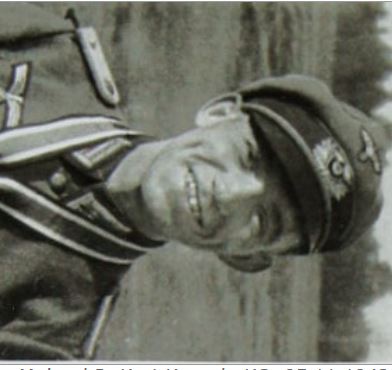Knaack, Kurt Hermann (Infanterie-Regiment 410)
- Date of birth:
- December 12th, 1915 (Berlin/Brandenburg, Germany)
- Date of death:
- April 6th, 1944 (Lembitu/Estonian SSR, USSR)
- Buried on:
- German War Cemetery Narwa / Narva
Grave: UNK. - Nationality:
- German
Biography
Kurt Knaack was posthumously promoted to Major der Reserve.
Do you have more information about this person? Inform us!
- Period:
- Second World War (1939-1945)
- Period:
- Second World War (1939-1945)
- Period:
- Second World War (1939-1945)
- Period:
- Second World War (1939-1945)
- Awarded on:
- 1942
- Period:
- Second World War (1939-1945)
- Rank:
- Oberleutnant der Reserve (1st Lieutenant of Reserves)
- Unit:
- Führer, 2. Kompanie, I. Bataillon, Infanterie-Regiment 410, 122. Infanterie-Division, Heer
- Awarded on:
- November 5th, 1942
“On the 30.10.1942 the 2./Grenadier-Regiment 410 was relieved of its positions along the railway embankment and sent on a 30 km forced night march to a new area of operations around Dedno. From here it was to advance towards the encircled Strongpoint ‘Kamerun’ on the following day in order to relieve the trapped friendly elements, bring up food/ammunition to the garrison and evacuate the wounded soldiers. After fulfilling this task it would then occupy the strongpoint and defend it against the anticipated enemy counterattacks.
After assembling near Strongpoint ‘Nord’ the 68-man strong Kompanie moved out to attack. The plan was to deceive the enemy by bombarding the strongpoints in the forests to the left of the open fields with strong infantry gun fire while also laying down artillery blocking fire on the enemy forces in the right wing forest. A few attached Panzers and 7.5 cm Pak received the task of suppressing enemy flanking fire from the forest to the left. The Kompanie formed up in a broad wedge (with the ammunition and supply carriers in the middle) and moved out. Alarm unit Hengst and Gruppe Bredenbröcker secured the right and left flanks. The Grenadiers then initiated a forest battle that the enemy was not prepared for. Pushing forward relentlessly, and while utilizing all available cover, it began. Enemy resistance was crushed swiftly and brutally wherever it appeared.
By 08:00 we had overrun the first strong enemy group with cries of ‘Hurra’. The supply and ammunition carriers had trouble keeping up with this tempo.
At around 09:00 a numerically superior enemy group succeeded in partially slowing down the attack with heavy fire. We thus struck the Russians in the right flank and threw them back from their position and into the forest beyond the open fields. The enemy losses were high. After a renewed onslaught we managed to finally reach the Strongpoint. Loud and jubilant cries of ‘Hurra’ greeted us, we were clearly expected.
The Strongpoint had been liberated by 11:00 in the morning. Favourable circumstances allowed the frontline to once again be closed here. This extraordinarily executed and bold attack resulted in enemy losses of 400 counted and a further 300 estimated dead. We also captured 1 heavy machine-gun, 16 light machine-guns, 1 German light machine-gun, 16 sub machine-guns, 3 anti-tank rifles, 1 mine detector, 1 sniper rifle and numerous other rifles.”
- Period:
- Second World War (1939-1945)
- Rank:
- Hauptmann (Captain)
- Unit:
- Führer, I. Bataillon, Grenadier-Regiment 410, 122. Infanterie-Division, Heer
- Awarded on:
- May 15th, 1944
Sources
- Photo 1:
- - FELLGIEBEL, W.P., Elite of theThird Reich, Helion & Company Limited, Solihull, 2003.
- Scheibert, Horst. Die Träger der Ehrenblattspange des Heeres und der Waffen-SS/ Die Träger der Ehrentaffelspange der Kriegsmarine/ Die Inhaber des Ehrenpokals für Besondere Leistung im Lukftkrieg. Friedberg, Ger.: Podzun-Pallas Verlag, 1986, ISBN 3-7909-0283-7
- Axis History Forum via Awardholders / unit
- NARA Roll T-78 R888
- Ritterkreuz Archiv IV/2010, Veit Scherzer, Ranis, September 2010, ISSN 1866-4709
- Die Träger des Ritterkreuzes des Eisernen Kreuzes 1939-1945
- Volksbund Deutsche Kriegsgräberfürsorge e.V.
- Weber, H., 122. Infanterie-Division: Erinnerungen der Pommersch -Mecklenburgischen Greif-Division, Oberaudorf, Germany, 1988
- Kurt Hermann Knaack | Gräbersuche-Online








